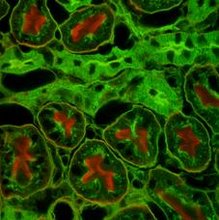Aim: To learn the technique of immunoelectrophoresis.
Principle:
Immunoelectrophoresis is a powerful technique to characterize antibodies. The technique is based on the principles of electrophoresis of antigens and immunodiffusion of the electrophoresed antigens with a polyspecific antiserum to form precipitin bands.
Electrophoresis:
During electrophoresis, molecules placed in an electric field acquire a charge and move towards appropriate electrode. Mobility of the molecule is dependent on a number of factors.
It is proportional to field strength and net charge of molecule.
Inversely proportional to frictional coefficient of the molecule which is dependent on size/shape of the molecule and viscosity of the medium.
Heat generated by high ionic strength buffers.
Changes in pH of buffer due to electrolysis of water.
Endosmosis: The agarose matrix adsorbs hydroxyl ions on the surface during electrophoresis, resulting in a net increase in positive ions, which migrate towards the negative electrode with a solvent shell. This net solvent flow is referred to as endosmosis. Sample molecules migrating against these ions meet resistance and are hindered in their movement, whereas sample molecules migrating along with the ions move faster.
Thus, when antigens are subjected to electrophoresis in an agarose gel, they get separated according to their acquired charge, size and shape, by migrating to different positions.
Immunodiffusion:
Antigens thus resolved by electrophoresis are subjected to immunodiffusion with antiserum added in a trough cut in the agarose gel. Due to diffusion, density gradient of antigen and antibody formed and at the zone of equivalence, antigen-antibody complex precipitates to form an opaque arc shaped line in the gel. The precipitin line indicates the presence of antibody, specific to the antigen. If the antibody is homogeneous only one precipitin line is visible. Presence of more than one precipitin line establishes the heterogeneity of antibody, while the absence of precipitin line indicates that the antiserum does not have antibody to any of the antigens separated by electrophoresis.
Materials:
Agarose, 5x electrophoresis buffer, Antigen, Test Antiserum-A, Test Antiserum-B.
Glassware: Conical flask, measuring cylinder.
Reagent: Distilled water.
Other Requirements: Micropipette, Tips, Moist chamber (box with wet cotton)
Methods:
Preparation of gel plate
Prepare 10 ml of 1.5% agarose (0.15 g/ml) in 1x electrophoresis buffer by heating slowly till agarose dissolves completely. Take care not to scorch/froth the solution.
Mark the end of a glass plate that will be towards negative electrode during electrophoresis.
Place the glass plate on a horizontal surface. Pipette and spread 10 ml of agarose solution onto the plate. Take care that the plate is not disturbed and allow the gel to solidify.
Place the glass plate on the template holder provided in ETS-2 and fix the template. Punch a 3 mm well with the gel puncher as shown in the figure 1, towards the negative end.
Cut two troughs with the gel cutter provided (in ETS-2), but do not remove the gel from the trough.
Electrophoresis:
Add 12-15 micro litter of antigen to the well.
Place the glass plate in the electrophoresis tank such that the antigen well is at the cathode/negative electrode. Pour 1x electrophoresis buffer such that it covers the gel.
Set the voltage to 50-100V and electrophorese until the blue dye travels 3-4 cms from the well. Do not electrophorese beyond 3 hours, as it is likely to generate heat.
Immunodiffusion:
Remove gel from both the troughs and keep the plate at room temperature for 15min. Add 250 micro litter of antiserum-A in one of the troughs and antiserum B in the other.
Place the plate in a moist chamber and allow diffusion to occur at room temperature, overnight.
Observation:
Observe for precipitin lines between antiserum troughs and the antigen well.
Interpretation:
Presence/absence of precipitin line indicates the presence/absence of antibody specific to antigen, respectively.
Presence of more than one line indicates the heterogeneity of the antiserum to the antigen.Presence of a single precipitin line indicates homogeneity of the antiserum to the antigen.
Subscribe to:
Post Comments (Atom)


1 comment:
Thanks for your nice explanation. Its good
Post a Comment